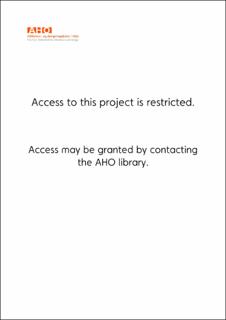| dc.description | The first part of the title ‘Learning to yarn with the land’ expresses the idea of relating with the land as a way of acting and establishing an approach to a project. It’s about letting impressions take hold and attempting to come closer to those qualities that one discovers, or are revealed by the place itself. Being careful to be as honest as possible to the things at hand and letting influence come from a space between ones own voice and that of the land, a kind of indirect voice.
In the pre study work to this diploma, I spent an amount of time at Lista on the South Western coast of Norway in an attempt to begin the process of this kind of approach and connect it to ideas of architecture. Hand drawing was established quickly as a principle tool for bringing forth the feeling and sensing one is confronted with when meeting a place. That way it can be quick and the intuitive voice can come through. I undertook a series of sky, land and rock drawings, walking and collecting as a way to come into dialogue with the surroundings. The changing light and clouds brought about awareness of the sky, always playing with the horizon and oceans surface. The great rocks at the coastline, captivating for their ability to be still between storm and sun days. The close presence of the land bringing forward the awareness of the different feeling we experience when a place is connected with the natural world to that of an urban setting. It was a move toward understanding the role of bringing a land orientated dialogue into an architecture.
Reflecting on ideas between land and inhabitation, I made three physical representations of principles that I hoped to work with in this kind of approach. The thinking tools (representations) were that of the camp, the shrine and spirit grounds.
Camp is a reference to a way of being that is close and communal. Where there is sense of openness and simplicity to lived daily life. A social place that is aware of the landscape it is in.
The shrine is a response to a question that I would like to work with, of celebration and respect, how an architecture can engage an awareness towards this, something that brings joy.
Spirit grounds is about creating a sense of identity and sharing a kind of ‘common place.’
The site I have chosen to work with is the headland between Østhasselstrand and Nordhasselvika on the south western part of the Lista peninsular in Southern Norway. The most obvious existing feature of the site is the massive concrete bunkers built by the Germans as part of the Atlantic wall fortifications of world war II. Prior to this layer of occupation, the site has been a focus for a cluster of burial mounds which are believed to have been made in the latter part of Stone Age to throughout the Bronze Age.
Although these narratives speak of different histories, they both reference an underlying strength of the site; A place in the land that offers something more than its immediate condition. In the case of the burial mounds, it was an act of ceremony. To leave the dead in mounds carefully situated, to exaggerate a natural point of local topography, lifting them toward the sky and out over the ocean. The bunkers and canon points are sited in direct connection with what the land offers, embedded within the old beach cliff for both vantage and camouflage.
I have tried to work with this offering in making a new place to re-inhabit the site. I found it was necessary to find a gesture that plays with the idea of celebration of place and land.
Throughout Lista there is a strong narrative of forest loss in the flatlands, forest that grew in the milder periods post ice age have now become the fields of agriculture. For hundreds of years, stories of shipwreck were tied to the exposed low-lying Lista coast. Still today, remnant pieces emerge from the sand on the beaches and the occasional fishing boat gets caught by fast approaching storm before reaching the Borhaug harbour. More often now, it is the tankers that roll past splitting the line of the horizon with their bow. Ever since people have occupied Lista, the daily life has been closely woven with that of the sea and land, and still the town is spirited with the life of the fisherman and the farmer.
The place I propose at Østhassel point aims to be a gathering place to celebrate at, with with the presence of the landscape acting as a unifier for all; locals and visitors. Somewhere that brings the land closer to the lives of its users. Something of the memories of the landscape and the previous narratives that have been lived there before. And something of a renewed expression that relates to the underlying offering of a powerful place in the land. | en_US |






